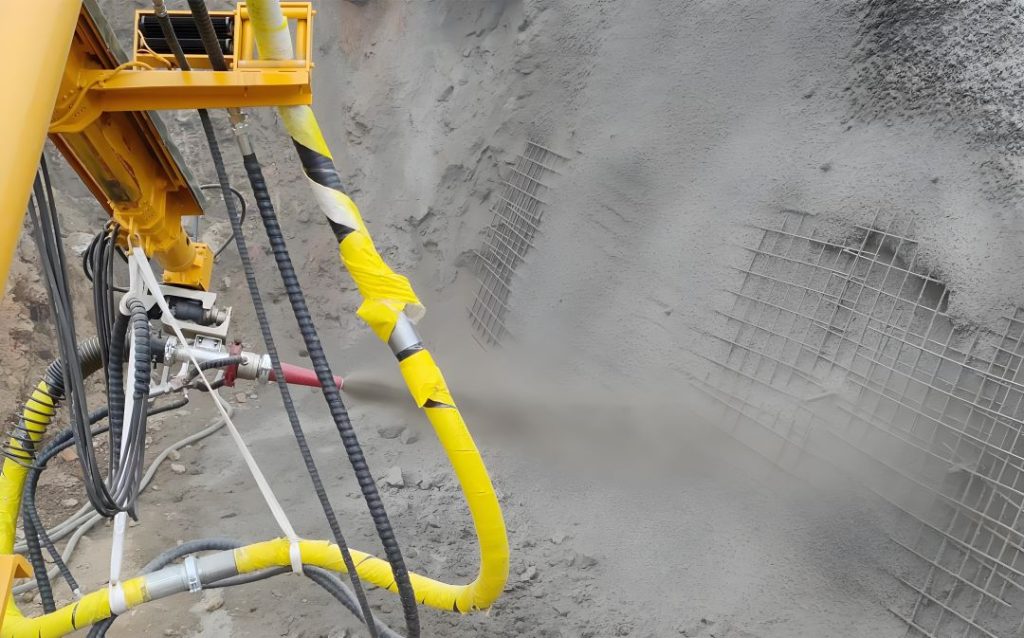What is the difference between Shotcreting and Sprayed Concrete?

1. Material Composition
- Shotcreting:
- The main material is cement mortar, which is made by mixing cement and sand in a certain proportion and then adding water for stirring. Generally, the ratio of cement to sand varies according to specific engineering requirements, for example, it can be 1:3 or 1:2.5, etc. Its composition is relatively simple, focusing on using the cementitious properties of cement and the filling properties of sand to form a protective layer or lining.
- For example, in some temporary projects with relatively low strength requirements or as a simple surface protective layer, shotcreting will be adopted. For instance, in the preliminary protection of some rock slopes, it only needs the cement mortar to form a protective layer on the slope surface to prevent weathering and small-scale falling of rocks.
- Sprayed Concrete:
- It is composed of cement, sand, gravel, admixtures, water and other materials. The addition of gravel gives it an advantage in structural performance compared to shotcreting. Gravel usually selects crushed stones with appropriate particle sizes, and crushed stones with a particle size of 5 - 10mm are quite common.
- For example, in the lining construction of tunnels, sprayed concrete can better withstand external loads such as rock and soil pressure by utilizing the skeleton structure formed by the gravel inside it, effectively preventing the deformation and collapse of the tunnel surrounding rock.
2. Performance Characteristics
- Strength:
- Shotcreting: It has relatively low strength. Since there is no coarse aggregate (gravel), its compressive strength mainly depends on the bonding of cement and sand. Generally, the compressive strength is about 10 - 20MPa, and it is often used in parts that bear relatively small loads.
- Sprayed Concrete: Due to the presence of gravel, it has higher strength. Its compressive strength can reach 20 - 40MPa or even higher, and it can withstand greater pressure and tension, so it is suitable for engineering parts with higher requirements for structural strength, such as the supporting structures of underground works and hydraulic structures.
- Durability:
- Shotcreting: Its durability mainly relies on the wrapping of cement paste around the sand and the anti-erosion performance of cement itself. In an environment with chemical erosion, its durability may be affected to some extent due to its relatively loose structure.
- Sprayed Concrete: Because of its good compactness and complete structural system (including coarse and fine aggregates), it has better durability. It can better resist the erosion of water, chemicals, and the damage caused by freeze-thaw cycles and other environmental factors.
3. Construction Technology
- Spraying Method:
- Shotcreting: Usually, an extrusion-type or pneumatic spray gun is used for spraying. During the spraying process, the stirred cement mortar is evenly sprayed on the working surface through the spray gun. Since there is no coarse aggregate in the material, the pressure requirement for the equipment during spraying is relatively low, and the equipment is also relatively simple.
- Sprayed Concrete: A special concrete spraying machine is required for spraying. Since the concrete contains gravel, in order to ensure that the gravel can be smoothly sprayed out and evenly distributed on the spraying surface, the spraying machine needs to have higher pressure and a more complex mixing and conveying system. During the spraying process, it is necessary to ensure that the concrete can be tightly bonded to the base surface, and at the same time, the spraying thickness and angle should be well controlled.
- Spraying Thickness:
- Shotcreting: The thickness is relatively thin, and the one-time spraying thickness is generally about 3 - 8mm. If it is necessary to increase the thickness, it usually needs to be sprayed in multiple layers, and sufficient interval time should be ensured between each layer to prevent the slurry that has not yet initial-set on the lower layer from being damaged.
- Sprayed Concrete: The one-time spraying thickness can reach about 5 - 10cm. This is because there is gravel inside it as a skeleton support, which can bear its own relatively large weight without collapsing. However, in actual construction, the appropriate spraying thickness should also be determined according to specific engineering requirements and the concrete mix ratio.
4. Application Scenarios
- Shotcreting:
- It is often used for temporary support in underground projects, such as the initial protection of small mine roadways, playing a role in simply sealing the surface of the surrounding rock to prevent it from weathering and peeling off.
- In some building surface repair projects with low requirements for structural appearance, it is used to fill small holes, pits and other surface defects and restore the flatness of the building surface.
- Sprayed Concrete:
- It is widely used in tunnel projects as part of the permanent lining structure, bearing the important role of supporting the surrounding rock and resisting the formation pressure.
- In the parts such as the slope protection of dams and the lining of canals in water conservancy projects, its high strength and good anti-scouring performance are utilized to protect the main structure of the project from the erosion and scouring of water flow.




